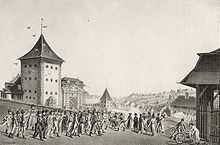Stecklikrieg

The Stecklikrieg (Stäcklichrieg) of 1802 resulted in the collapse of the Helvetic Republic, the renewed French occupation of Switzerland and ultimately the Act of Mediation dictated by Napoleon on 10 March 1803.
The conflict itself was between federalist insurgents, mostly of the rural population, and the official Helvetic Republic. The name Stäckli "wooden club" refers to the improvised weaponry of the insurgents.
Following the Treaty of Lunéville, the French troops left Switzerland during the summer of 1802, resulting in rapid destabilization of the country. The insurgence originated in Central Switzerland, the cities of Zürich and Bern as well as rural parts of the Swiss plateau (Aargau and Solothurn). After several hostile clashes with the official forces of the Helvetic Republic, which were lacking both in equipment and motivation (Renggpass at Pilatus on 28 August, artillery attacks on Bern and Zürich during September, and a skirmish at Faoug on 3 October), the central government at first capitulated militarily (on 18 September, retreating from Bern to Lausanne) and then collapsed entirely. It was succeeded by cantonal governments, and a Tagsatzung in Schwyz led by Alois von Reding.
Napoleon was concerned that the instability of Switzerland could infect Europe at large, and re-occupied Switzerland immediately after the collapse of the central government. His Act of Mediation however made concessions to the demands of the insurgents, abandoning the centralist structure of the Helvetic Republic in favour of a more federalist approach. French intervention constituted a breach of the Treaty of Lunéville, which was taken as a pretext by the United Kingdom to declare war on France on 18 May 1803.
William Wordsworth's poem Thought of a Briton on the Subjugation of Switzerland is directly inspired by the events of the Stecklikrieg.
External links
- Stecklikrieg in German, French and Italian in the online Historical Dictionary of Switzerland.